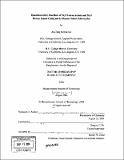| dc.contributor.advisor | Gregory C. Fu. | en_US |
| dc.contributor.author | Mermerian, Ara Haig, 1976- | en_US |
| dc.contributor.other | Massachusetts Institute of Technology. Dept. of Chemistry. | en_US |
| dc.date.accessioned | 2005-09-27T17:51:18Z | |
| dc.date.available | 2005-09-27T17:51:18Z | |
| dc.date.copyright | 2004 | en_US |
| dc.date.issued | 2004 | en_US |
| dc.identifier.uri | http://hdl.handle.net/1721.1/28700 | |
| dc.description | Thesis (Ph. D.)--Massachusetts Institute of Technology, Dept. of Chemistry, 2004. | en_US |
| dc.description | Vita. | en_US |
| dc.description | Includes bibliographical references. | en_US |
| dc.description.abstract | (cont.) imine. | en_US |
| dc.description.abstract | The enantioselective C-acylation of cyclic silyl ketene acetals was achieved catalytically by employing planar-chiral heterocycles derived from 4-(pyrrolidino)pyridine. Key mechanistic features of this process involve activation of both the electrophile (acylating agent --> acylpyridinium) and the nucleophile (silyl ketene acetal --> enolate). This process accomodates a wide variety of aryl- and heteroaryl-substituted silyl ketene acetals, furnishing quaternary stereocenters with enantioselectivities up to 99%. Further investigation of this process revealed that acyclic disubstituted silyl ketene acetals can also participate in this nucleophile-catalyzed process, furnishing enantioselectivities up to 97%. Isomeric mixtures of silyl ketene acetals are efficiently converted into the same enantiomer of the product β-ketoester, rendering this a stereoconvergent catalytic C-acylation process. Silyl ketene imines were also shown to be suitable reaction partners in this catalytic enantioselective C-acylation reaction, affording nitriles bearing an adjacent quaternary stereocenter with enantioselectivies up to 83%. This process is also believed to proceed via activation of the electrophile (acylating agent --> acylpyridinium) and the nucleophile (silyl ketene imine --> nitrile anion), which is in direct analogy to the process developed for silyl ketene acetals. Application of this transformation to the enantioselective total synthesis of (S)-Verapamil was successfully achieved in 8 steps and 25% overall yield from commercially available 3,4-dimethoxyphenylacetonitrile. The key bond construction in this total synthesis involved enantioselective construction of the quaternary stereocenter via a catalytic C-acylation of a silyl ketene | en_US |
| dc.description.statementofresponsibility | by Ara Haig Mermerian. | en_US |
| dc.format.extent | 298 p. | en_US |
| dc.format.extent | 10544370 bytes | |
| dc.format.extent | 10584253 bytes | |
| dc.format.mimetype | application/pdf | |
| dc.format.mimetype | application/pdf | |
| dc.language.iso | en_US | |
| dc.publisher | Massachusetts Institute of Technology | en_US |
| dc.rights | M.I.T. theses are protected by copyright. They may be viewed from this source for any purpose, but reproduction or distribution in any format is prohibited without written permission. See provided URL for inquiries about permission. | en_US |
| dc.rights.uri | http://dspace.mit.edu/handle/1721.1/7582 | |
| dc.subject | Chemistry. | en_US |
| dc.title | Enantioselective reactions of silyl ketene acetals and silyl ketene imines catalyzed by planar-chiral heterocycles | en_US |
| dc.type | Thesis | en_US |
| dc.description.degree | Ph.D. | en_US |
| dc.contributor.department | Massachusetts Institute of Technology. Department of Chemistry | |
| dc.identifier.oclc | 59133141 | en_US |
